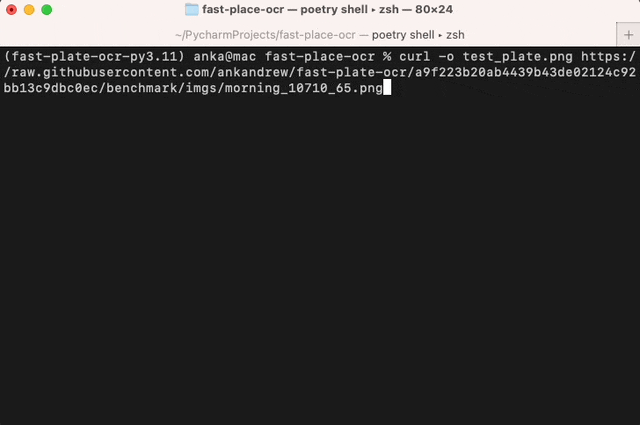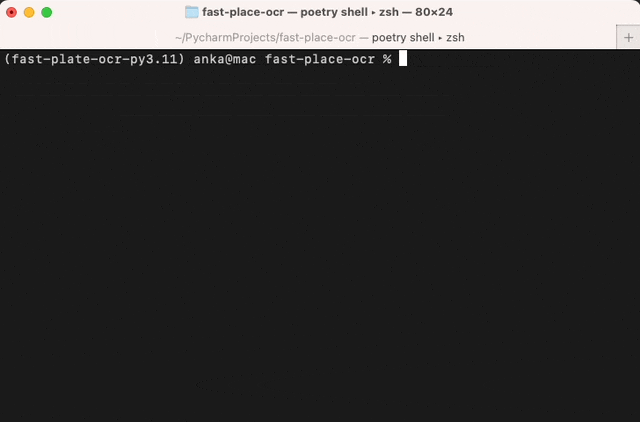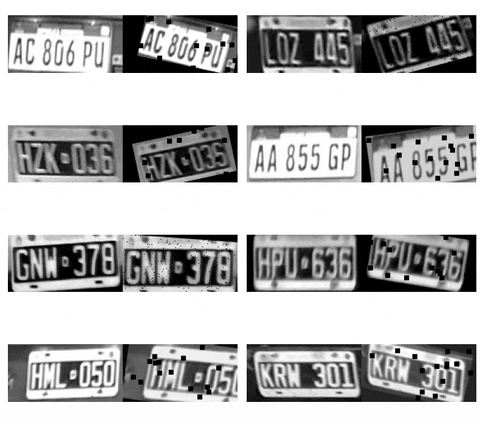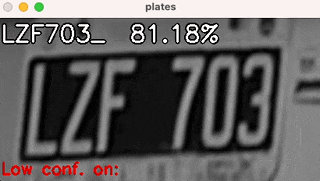Fast & Lightweight OCR for vehicle license plates.
Project description
Fast & Lightweight License Plate OCR
Introduction
Lightweight and fast OCR models for license plate text recognition. You can train models from scratch or use the trained models for inference.
The idea is to use this after a plate object detector, since the OCR expects the cropped plates.
Features
- Keras 3 Backend Support: Compatible with TensorFlow, JAX, and PyTorch backends 🧠
- Augmentation Variety: Diverse augmentations via Albumentations library 🖼️
- Efficient Execution: Lightweight models that are cheap to run 💰
- ONNX Runtime Inference: Fast and optimized inference with ONNX runtime ⚡
- User-Friendly CLI: Simplified CLI for training and validating OCR models 🛠️
- Model HUB: Access to a collection of pre-trained models ready for inference 🌟
Available Models
| Model Name | Time b=1 (ms)[1] |
Throughput (plates/second)[1] |
Dataset | Accuracy[2] | Dataset |
|---|---|---|---|---|---|
| argentinian-plates-cnn-model | 2.0964 | 477 | arg_plate_dataset.zip | 94.05% | Non-synthetic, plates up to 2020. |
[1]Inference on Mac M1 chip using CPUExecutionProvider. Utilizing CoreMLExecutionProvider accelerates speed by 5x.
[2] Accuracy is what we refer as plate_acc. See metrics section.
Reproduce results.
-
Calculate Inference Time:
pip install fast_plate_ocr # CPU # or pip install fast_plate_ocr[inference_gpu] # GPU
from fast_plate_ocr import ONNXPlateRecognizer m = ONNXPlateRecognizer("argentinian-plates-cnn-model") m.benchmark()
-
Calculate Model accuracy
pip install fast-plate-ocr[train] curl -LO https://github.com/ankandrew/fast-plate-ocr/releases/download/v1.0/arg_cnn_ocr_config.yaml curl -LO https://github.com/ankandrew/fast-plate-ocr/releases/download/v1.0/arg_cnn_ocr.keras curl -LO https://github.com/ankandrew/fast-plate-ocr/releases/download/v1.0/arg_plate_benchmark.zip unzip arg_plate_benchmark.zip fast_plate_ocr valid \ -m arg_cnn_ocr.keras \ --config-file arg_cnn_ocr_config.yaml \ --annotations benchmark/annotations.csv
Inference
For inference only, install:
pip install fast_plate_ocr
For doing inference on GPU, install:
pip install fast_plate_ocr[inference_gpu]
Usage
To predict from disk image:
from fast_plate_ocr import ONNXPlateRecognizer
m = ONNXPlateRecognizer('argentinian-plates-cnn-model')
print(m.run('test_plate.png'))
run demo
To run model benchmark:
from fast_plate_ocr import ONNXPlateRecognizer
m = ONNXPlateRecognizer('argentinian-plates-cnn-model')
m.benchmark()
benchmark demo
CLI
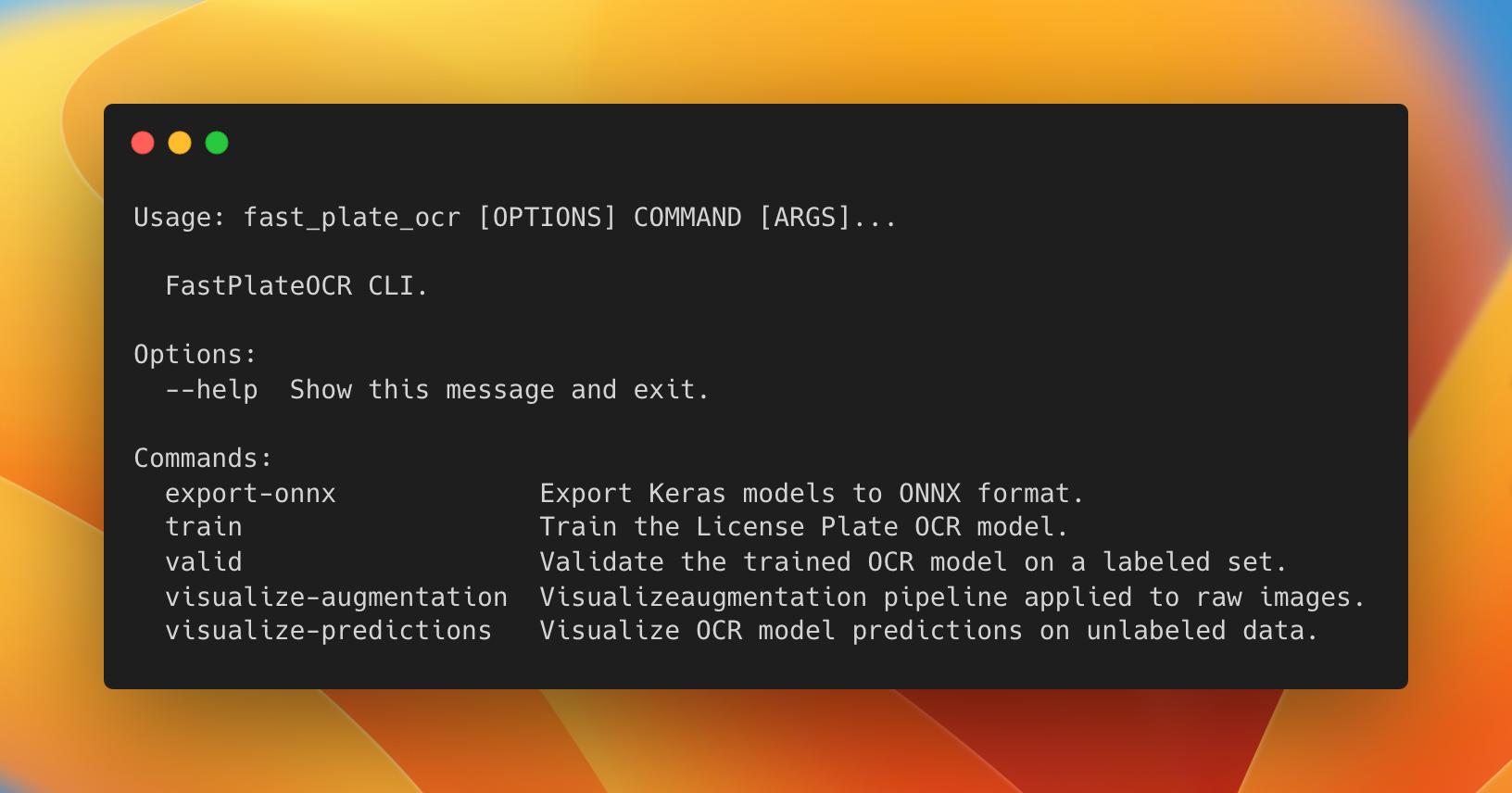
To train or use the CLI tool, you'll need to install:
pip install fast_plate_ocr[train]
Train Model
To train the model you will need:
- A configuration used for the OCR model. Depending on your use case, you might have more plate slots or different set
of characters. Take a look at the config for Argentinian license plate as an example:
# Config example for Argentinian License Plates # The old license plates contain 6 slots/characters (i.e. JUH697) # and new 'Mercosur' contain 7 slots/characters (i.e. AB123CD) # Max number of plate slots supported. This represents the number of model classification heads. max_plate_slots: 7 # All the possible character set for the model output. alphabet: '0123456789ABCDEFGHIJKLMNOPQRSTUVWXYZ_' # Padding character for plates which length is smaller than MAX_PLATE_SLOTS. It should still be present in the alphabet. pad_char: '_' # Image height which is fed to the model. img_height: 70 # Image width which is fed to the model. img_width: 140
- A labeled dataset, see arg_plate_dataset.zip for the expected data format.
- Run train script:
# You can set the backend to either TensorFlow, JAX or PyTorch # (just make sure it is installed) !KERAS_BACKEND=tensorflow fast_plate_ocr train \ --annotations path_to_the_train.csv \ --val-annotations path_to_the_val.csv \ --batch-size 128 \ --epochs 750 \ --dense \ --early-stopping-patience 100 \ --reduce-lr-patience 50
You will probably want to change the augmentation pipeline to apply to your dataset. In order to do this
Define Albumentations pipeline:
import albumentations as A
transform_pipeline = A.Compose(
[
# ...
A.RandomBrightnessContrast(brightness_limit=0.1, contrast_limit=0.1, p=1),
A.MotionBlur(blur_limit=(3, 5), p=0.1),
A.CoarseDropout(max_holes=10, max_height=4, max_width=4, p=0.3),
# ... and any other augmentation ...
]
)
# Export to a file (this resultant YAML can be used by the train script)
A.save(transform_pipeline, "./transform_pipeline.yaml", data_format="yaml")
And then you can train using the custom transformation pipeline with the --augmentation-path option.
Visualize Augmentation
It's useful to visualize the augmentation pipeline before training the model. This helps us to identify if we should apply more heavy augmentation or less, as it can hurt the model.
You might want to see the augmented image next to the original, to see how much it changed:
fast_plate_ocr visualize-augmentation \
--img-dir benchmark/imgs \
--columns 2 \
--show-original \
--augmentation-path '/transform_pipeline.yaml'
You will see something like:
Validate Model
After finishing training you can validate the model on a labeled test dataset.
Example:
fast_plate_ocr valid \
--model arg_cnn_ocr.keras \
--config-file arg_plate_example.yaml \
--annotations benchmark/annotations.csv
Visualize Predictions
Once you finish training your model, you can view the model predictions on raw data with:
fast_plate_ocr visualize-predictions \
--model arg_cnn_ocr.keras \
--img-dir benchmark/imgs \
--config-file arg_cnn_ocr_config.yaml
You will see something like:
Export as ONNX
Exporting the Keras model to ONNX format might be beneficial to speed-up inference time.
fast_plate_ocr export-onnx \
--model arg_cnn_ocr.keras \
--output-path arg_cnn_ocr.onnx \
--opset 18 \
--config-file arg_cnn_ocr_config.yaml
Keras Backend
To train the model, you can install the ML Framework you like the most. Keras 3 has support for TensorFlow, JAX and PyTorch backends.
To change the Keras backend you can either:
- Export
KERAS_BACKENDenvironment variable, i.e. to use JAX for training:KERAS_BACKEND=jax fast_plate_ocr train --config-file ...
- Edit your local config file at
~/.keras/keras.json.
Note: You will probably need to install your desired framework for training.
Model Architecture
The current model architecture is quite simple but effective. See cnn_ocr_model the code.
The model output consists of several heads. Each head represents the prediction of a character of the
plate. If the plate consists of 7 characters at most (max_plate_slots=7), then the model would have 7 heads.
Example of Argentinian plates:
Each head will output a probability distribution over the vocabulary specified during training. So the output
prediction for a single plate will be of shape (max_plate_slots, vocabulary_size).
Model Metrics
During training, you will see the following metrics
- plate_acc: Compute how many plates were correctly classified. For a single plate, if ground truth is
ABC123, and the prediction is 'ABC 123', then this would give a score of 1. If the prediction was ABD 123, it would score 0. - cat_acc: Calculates how many characters of the plate were correctly classified. Example if the correct label is
ABC123andABC133is predicted, it will not give a precision of 0% like plate_acc (not completely classified correctly), but 83.3% (5/6). - top_3_k: Calculates how often the true character is found in the top-3 predictions (the 3 with the highest probability).
Metrics are defined in this custom.py module.
Contributing
Contributions to the repo are greatly appreciated. Whether it's bug fixes, feature enhancements, or new models, your contributions are warmly welcomed.
To start contributing or to begin development, you can follow these steps:
- Clone repo
git clone https://github.com/ankandrew/fast-plate-ocr.git
- Install all dependencies using Poetry:
poetry install --all-extras
- To ensure your changes pass linting and tests before submitting a PR:
make checks
If you want to train a model and share it, we'll add it to the HUB 🚀
TODO
- Expand model zoo.
- Use synthetic image plates.
- Finish and push TorchServe files.
Project details
Download files
Download the file for your platform. If you're not sure which to choose, learn more about installing packages.
Source Distribution
Built Distribution
File details
Details for the file fast_plate_ocr-0.1.0.tar.gz.
File metadata
- Download URL: fast_plate_ocr-0.1.0.tar.gz
- Upload date:
- Size: 26.4 kB
- Tags: Source
- Uploaded using Trusted Publishing? Yes
- Uploaded via: twine/5.0.0 CPython/3.12.2
File hashes
| Algorithm | Hash digest | |
|---|---|---|
| SHA256 | 2f29da506538af990cf6a409ec7030ce6377485f05ed1d45193fd74be4b3cf8c |
|
| MD5 | a18c526d0b6c8f5a51ce40ca70b9581f |
|
| BLAKE2b-256 | dfa81ed70c894162fc93a9d089f5737f4f0b7c672655fe803db34269a45930ca |
File details
Details for the file fast_plate_ocr-0.1.0-py3-none-any.whl.
File metadata
- Download URL: fast_plate_ocr-0.1.0-py3-none-any.whl
- Upload date:
- Size: 30.9 kB
- Tags: Python 3
- Uploaded using Trusted Publishing? Yes
- Uploaded via: twine/5.0.0 CPython/3.12.2
File hashes
| Algorithm | Hash digest | |
|---|---|---|
| SHA256 | e75b7cab22b38ef59768ecdfcb17878e93802722ad0c1eff100a91d7a20eac32 |
|
| MD5 | 19b9f49f0ebfabf9b4d58c13c2aba9ab |
|
| BLAKE2b-256 | 069a91953bbb5a400e99ca1c958abd08190c62411c95524ac7bda00c80335cb8 |











